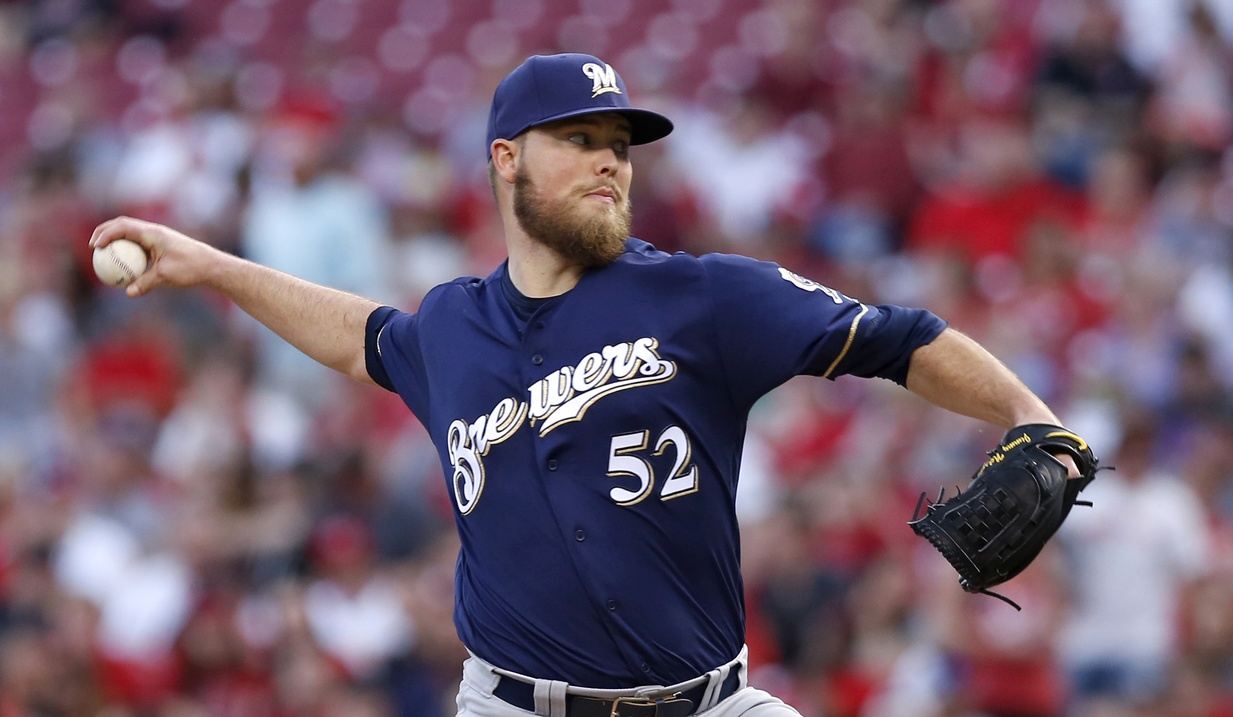It took ten games to get there, but the Brewers are back to square one: 5-5, 40 runs scored / 39 runs allowed, perfectly even. Milwaukee made their way back to even against Curveballer Bronson Arroyo and the Cincinnati Reds, and thanks to Jimmy Nelson and Ryan Braun. After facing some tough customers at Miller Park to open the season, the Brewers are blowing this thing open on the road, winning their third straight from the visitor’s clubhouse.
Top Play (19 percent)
Ryan Braun was already in rare company having improved during his age-32 season, and thus far the age-33 Franchise Player is showing that his power is not going anywhere. While the rest of Braun’s game warms up, the veteran is hitting big flies, including one that brought the Brewers back into the game on Sunday versus the Cubs. Last night’s game was no different, as Braun smacked a two-run homer to provide the Brewers some immediate insurance runs during their four-run-Fourth-Inning. That homer swung the Brewers’ odds of winning from 59 percent to 78 percent.
The Brewers are not really hitting thus far, but their runs scored do not reflect that; their mark of 40 runs over ten games is within three runs of the league average. Granted, this pace would result in a significantly below average offense for the full season (approximately 50 runs below average over 162), but the Brewers are sticking in games because of their excellent power. Braun is a mascot for this current batting line, boasting a .226 / .333 / .516 line (.287 Total Average). Against a National League batting .246 / .319 / .409, the Brewers’ line of .231 / .293 / .435 leaves something to be desired in terms of batting and on-base performances. That slugging is excellent, however, and it begs the question about how good the Brewers offense could be should those other categories slide closer to average; of course, that progression could also drain power, and there is also the possibility that this simply is who the Brewers are: strike outs and homers galore.
Bottom Play (-4 percent)
The worst WPA of the game occurred during the bottom of the first inning, as Jimmy Nelson could not retire speedster Billy Hamilton. Hamilton smacked an off-speed pitch (MLB GameDay called it a change up) to left field to open the Reds’ attempts at the plate. This event immediately shifted the game in the favor of the home club, moving their odds of winning to 58 percent. Hamilton stole second, but Nelson locked down, allowing one run on a Joey Votto sacrifice fly to limit the damage during the inning.
Much has been made over the years of Nelson’s off-speed pitches, as the righty shifted from his sinker / slider meat-and-potatoes to add a curveball, and now an (apparent) “split-change.” What shined on Thursday night was the fastball, which Nelson relied on heavily during his opening innings of work. To close the first inning, Nelson used 14 consecutive fastballs or “sinkers” to retire Reds batters, and he continued that trend as the game wore on: 15 in the second, 11 in the third, four in the fourth, and 20 in the fifth, 4 in the sixth, and 12 in the seventh. Out of 101 pitches, Nelson went to his heat 83 times, simply blowing away the Reds with a consistent set of fastballs.
This is a fine development from Nelson, who has a perpetual set of “what if?” from Brewers fans and analysts. But where the questions usually focus on off-speed stuff, or command, or what have you, the answers have often been framed in “if Nelson can only make pitch ___________ work,” or “Nelson’s new pitch will _______________.” Now, Nelson’s move to his heat is the best possible answer.
Odds and Ends: Thus far, the Brewers are almost a perfectly average fielding club in terms of Defensive Efficiency. How does this compare to FRAA?
Behind Orlando Arcia, Hernan Perez is the best fielder on the club, using a 1.1 FRAA around the diamond to offset his cold start at the plate. That would be the seemingly logical line, except for the fact that among regular Brewers, Ryan Braun is even better in the field than Arcia thus far; Braun is using a 2.0 FRAA and that .287 TAv to drive the club in WARP.
Jesus Aguilar is the better defensive first baseman thus far (!!!), but he and Eric Thames are ultimately a wash at first…Domingo Santana is who we thought he is, even as his bat is beginning to be what we dreamed it could be. Against a .304 TAv, Santana’s dreadful defense is already worth -1.5 FRAA after nine games…Orlando Arcia had a great night at the plate, to go along with his stellar defense thus far (his FRAA perfectly offsets Santana’s)…Jett Bandy and Manny Pina have provided great offense at catcher thus far, but their defense is a wash (0.4 FRAA for Pina against -0.5 FRAA for Bandy)…Kirk Nieuwenhuis and Keon Broxton leave much to be desired in center field, combining for -0.6 FRAA thus far…At third base, Travis Shaw is also coming up short thus far, but history says the glove might come around….For all the bellyaching about Jonathan Villar’s defense, he is not close to the worst defender on the club thus far.
Up Next:
Friday: LHP Tommy Milone (-$0.8M surplus entering 2017, 4.99 career DRA) vs. RHP Scott Feldman ($0.9M surplus, 4.54 career DRA)
Saturday: RHP Zach Davies ($22.9M surplus, 3.92 DRA) vs. LHP Brandon Finnegan ($9.8M surplus, 4.60 career DRA)
Sunday: RHP Wily Peralta (-$3.3M surplus, 4.84 career DRA) vs. TBD [Robert Stephenson / Cody Reed / Sal Romano].
Note: Updated DRA lines is severely impacting some surplus numbers I published earlier this offseason. Peralta is one such victim.
